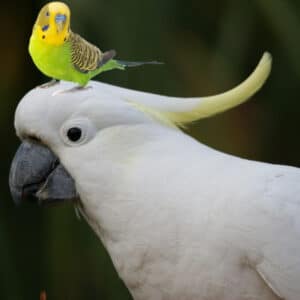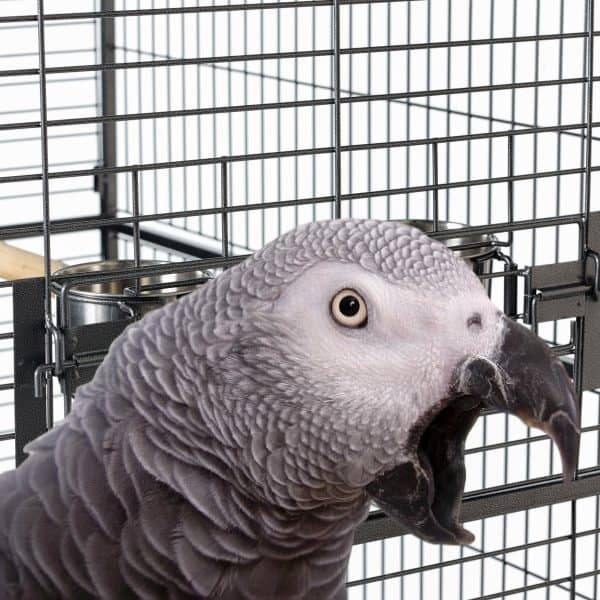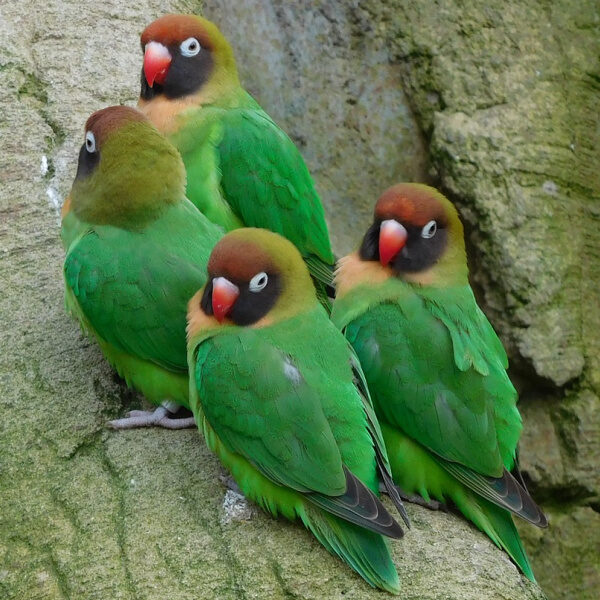
How To Set-up A Handicapped Galah Parrot Cage
Last Updated on by Mitch Rezman
I have a young Galah parrot (aka rose-breasted cockatoo) who is missing her toes on one foot.
She was three weeks old when she developed constricted toe and had the amputation, so she really has no idea that she’s handicapped.
Editor’s note: Animals never do.
She’s a little over two years old now. (1st April 2016)
My question is about cage-scaping to accommodate this and make her as comfortable as possible when she has to be in her cage.
Vet wrap seems to have helped with making perches softer and easier for her to grab.
She came with an old re-purposed cockatiel cage that seems small and poorly suited.
I want to upgrade her house and make it easier for me to clean, too.
I know there won’t be any hard and fast definitive answers.
I’m looking for ideas and help with figuring out how to give her and the senior Severe Macaw I inherited with her the best life I possibly can.
So, I’m calling out to my tribe of bird-loving people and asking for the benefit of other experiences than mine.
I’ve only ever had littles–parakeets, cockatiels and finches.
So a mini Macaw and a Galah are a different experience for me.
I’m looking for general ideas on size and helpful placement of perches.
Thank you for your time
Hi Donna,
Thank you for paying your due diligence with respect to specific species. Not saying simply that you have a macaw and a cockatoo is most helpful. Answering your questions in sequence, beginning with the missing toes. Parrots have zygodactyl feet having two toes pointing forward and two toes facing rear.
You do not indicate which of the two toes are missing but this should not be a huge challenge for your Galah aka Rose-breasted cockatoo.
Parrots have no muscles in their legs below thighs level.
Only two (flexor) tendons in each leg ending just before the toenail.
Their ability to grip is controlled by the ankle’s angle.
This is why birds can sleep on 1 foot.
The feet “clamp-on“, not relying on muscle strength.
That said I would advocate introducing some flat perches be they, flat Manzanita, wood platforms, metal corner shelves – anything offering a horizontal surface where the bird can “take a load off”
Ladders in birdcages can work horizontally as well.
The majority of perches should be soft rope like the “Booda” brand, especially for sleeping,
Any other perches be they wooden or plastic should not be a straight dowel rods (like the ones that come with cages) but must exhibit uneven surfaces to challenge your bird’s feet.
Your galah will want to sleep high in the cage but I would advocate moving more perches in the (horizontal) center of the cage and providing entertainment at the bottom of the cage so he or she spends time there as well and does less climbing.
Have you fully learned the most engaging toys for both your birds?
Some birds like to shred paper and wood like our Senegal, Peaches.
Our newly rescued African ringneck Keto, goes gaga for bells.
We are training him using bell toys to move between cages and to become less “hand phobic”.
Especially because of the missing toe it’s important to keep your bird fully flighted because they use their wings for balance a great deal of the time.
A bird without the ability to properly balance and a handicap foot increase the chances of falling in a crowded cage and injuring a wing.
Keeping a handicap flighted bird also means you have to be very aware of landing zones that are easy to acquire for the bird.
Places where he or she could play (forage) on a flat surface like a desk or spare table.
I use lots of little boxes like those that Harry’s razors come in.
The boxes can come from electronics, contact lenses, toothpaste – use your imagination.
They (Harry’s boxes) have drawers which get filled with high-value treats.
Anything offered are semi-high value treats forcing Peaches our Senegal to to work for her food.
I also use small open boxes and fill them with business cards in larger low wall Tupperware type containers filled with the cardboard product tags that come with bird toys.
I sprinkle some sunflower seeds, crush a couple of Nutri-berries in between all these product cards.
You’d be amazed how much time it keeps her occupied, on a flat surface which is ideal for you and your bird’s situation.
Remember that you have two species that are indigenous to two different continents.
Just because they are both parrots doesn’t mean they are going to get along with each other.
Think of all the humans that are one single species – in the Mideast.
Why can’t everyone get along?
I’m sure you’re working through “out of the cage” time for both birds.
With Keto in our home for barely going on two weeks and is fully flighted (Peaches is too), only one of the birds is allowed out of its cage at a time.
Keto seems to be less interested in outside of the cage and more interested in the environment we built for him but he will come out to the top and play with jingly plastic balls.
He LOVES ringing his bell toys.
I’m confident we can teach him how to play basketball.
Things to do when not in the cage are as important than everything in the cage because you don’t want your birds to damage your property.
They don’t know the difference between a box with business cards and that priceless hand-carved wooden music box handed down to you from your great-grandmother.
Make them comfortable, feed them well and use full-spectrum lighting no more than 6 inches from the top of each cage on a timer set for 12 hours of light and 12 hours of darkness.
Light Cycles are the second most important element in your birds environment after nutrition.
Best of luck
MitchR
Author Profile
Latest entries
 The Traveling BirdJune 26, 2025Can You Name 5 Parrot Species That Are Living Wild in the USA?
The Traveling BirdJune 26, 2025Can You Name 5 Parrot Species That Are Living Wild in the USA? Bird BehaviorJune 26, 2025How is it Parrots Are Problem Solvers Social Animals and Even Use Tools?
Bird BehaviorJune 26, 2025How is it Parrots Are Problem Solvers Social Animals and Even Use Tools? Bird & Parrot AnatomyJune 25, 2025How a Tiny Chemical Modification Makes Parrots Nature’s Living Paintings
Bird & Parrot AnatomyJune 25, 2025How a Tiny Chemical Modification Makes Parrots Nature’s Living Paintings PigeonsJune 20, 2025How Do Parrots Thrive in Cities Outside Their Native Habitats?
PigeonsJune 20, 2025How Do Parrots Thrive in Cities Outside Their Native Habitats?


